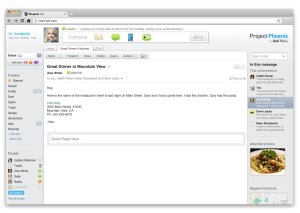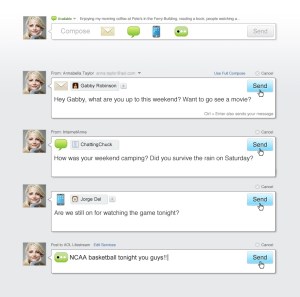Yesterday, the company previewed the new AOL Mail, code-named Project Phoenix, an influential shift in the new direction of the once-reigning “king of the inbox” – and we got a special sneak preview last week. The new platform is a snazzy twist on the standard e-mail fare, but it’s not only the new bells and whistles (and there are quite a few) that could give AOL a newfound edge in the e-communication market, it’s the thought behind it.
(More on Techland: Is Facebook Prepping A New E-mail System?)
 It’s no secret that AOL mail has become antiquated – a relic of the Internet boom and 90s romcoms, but the company knows its audience. AOL Mail is still the bread and butter of e-mail for the over 50 set (a large section of its 30 million users), and the company recognizes the mass resistance that would be likely in this audience were it to force feed them this new, flashy update. Instead, they’re finally setting a divider. That’s right. Phoenix is an e-mail system for the young (or young at heart) and AOL isn’t shy about admtting it. But how to best appeal to two polarizing user bases? Separate them.
It’s no secret that AOL mail has become antiquated – a relic of the Internet boom and 90s romcoms, but the company knows its audience. AOL Mail is still the bread and butter of e-mail for the over 50 set (a large section of its 30 million users), and the company recognizes the mass resistance that would be likely in this audience were it to force feed them this new, flashy update. Instead, they’re finally setting a divider. That’s right. Phoenix is an e-mail system for the young (or young at heart) and AOL isn’t shy about admtting it. But how to best appeal to two polarizing user bases? Separate them.
That’s right. For the first time, an email provider is declaring the gap between the Internet savvy and the preferred basic user (read: the young and the old) too vast to bridge. Instead, the company will roll out Project Phoenix alongside its existing AOL Mail, not in place of it. “We recognize that there are different segments of our audience,” Brad Garlinghouse, President of Consumer Applications at AOL, said. “There’s a segment that will continue to use our traditional AOL Mail and that’s lovely. Project Phoenix is going after a different market segment that is underserved due to so little innovation in the e-mail space.”
In a move to attract the young, users will be able to choose from five domain names: love.com, wow.com, games.com, ygm.com (You’ve Got Mail) as well as the standard aol.com. Also with Phoenix, AOL is recycling its hundreds of millions of retired usernames for the first time, meaning you could see your early 90s online doppelganger raised from its Web grave. With a wider spread of namespace, users will be able to choose a simpler e-mail handle, meaning there’ll be five of each to go around. With multiple domain options (already in use in Germany and China) we’ll see less scrambled abbreviations grouped with additional number combinations. Say goodbye, aktown33. You won’t be missed.
(More on Techland: Nudgemail Service Encourages E-mail Procrastination)
 As for the picks, phrases like ‘games’ and ‘wow’ will most likely appeal the the younger set, specifically tweens issuing their first e-mail account. These users will be online for social reasons, therefore the fact that Phoenix has yet to incorporate a Google Docs equivalent won’t matter. (Perhaps the largest hurdle Phoenix faces is with Gmail’s dedicated usership, which is deeply entrenched in Google’s free cloud-based file storage unit. Unless it figures out a savvier equal, Gmailers will probably only dabble with Phoenix out of timely curiosity.)
As for the picks, phrases like ‘games’ and ‘wow’ will most likely appeal the the younger set, specifically tweens issuing their first e-mail account. These users will be online for social reasons, therefore the fact that Phoenix has yet to incorporate a Google Docs equivalent won’t matter. (Perhaps the largest hurdle Phoenix faces is with Gmail’s dedicated usership, which is deeply entrenched in Google’s free cloud-based file storage unit. Unless it figures out a savvier equal, Gmailers will probably only dabble with Phoenix out of timely curiosity.)
Phoenix is arguably the most friendly e-mail platform ever created. Total aggregation pulls in inboxes from around the Web, Gmail, Yahoo, Hotmail – even Facebook or Linkedin, but it’s not a mail forwarding service. Each inbox will exist inside of your AOL Mail as an independent hub that can be accessed on its own or as a part of your main AOL inbox. Replies can also be sent out by whichever address you choose, just select the one you want to use from a drop down menu that appears above the e-mail.
AOL takes Phoenix’s seamless aggregation even further with e-mails, IMs, SMS or social media status updates all accessible by the Quick Bar, a one-click tool that allows users to send out messages on a multitude of platforms at rapid fire, all without having to leave your inbox. You can even access attachments found in the displayed messages via the new Smart View, a stationary group of thumbnail previews that senses photos and and displays them for easy download, or flip through with Phoenix’s slideshow feature – again, all without leaving your inbox. (Bonus: If Smart View detects an address in your inbox, it will automatically pull up a map of the location via Map Quest.)
(More on Techland: Two-minute Video: 10 Simple Gmail Tricks)
Set to begin beta testing next week, AOL will issue invites to thousands with a full launch set to open Phoenix to the masses early next year. Garlinghouse tells me that while no mobile version of Phoenix is available, an HTML 5 Quick Bar app is certainly “on the radar.” Though already impressively decorated, Phoenix is still a labeled a work in progress, as it should be according to Garlinghouse. “E-mail in particular is a space where I feel there has been very little innovation,” he said. “The last big thing to happen to e-mail was Gmail. When Gmail first came out, it was a gig of storage and it was a massive shift from the industry, but since then things have been stagnant. We want to change that.” Which they will, unless Facebook soaks up the tweens with its own e-mail platform first.
More on Time.com:

